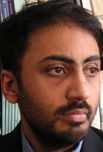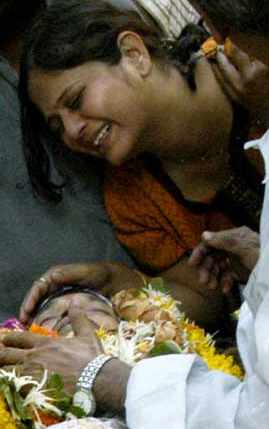FEAR AND TREMBLING IN MUMBAI

by
SADANAND DHUME
___________
Sadanand
Dhume, a fellow at the Asia Society in Washington, DC, and the
author of My Friend the Fanatic, a travelogue about
radical Islam.
 Even
for India, which typically loses many more lives to terrorism
in a year than most countries do in a decade, the November 26-28
attacks on Mumbai marked a watershed. For the first time, foreigners
– Americans, Japanese, Israelis and Germans, among others
– were among the nearly 200 dead and 295 wounded. The
scale of the attacks, carried out in 10 places by 10 heavily
armed jihadists, made the 2001 terrorist assault on India’s
parliament appear almost trivial by comparison. In its audacity
and ruthlessness, as well as in the wall-to-wall international
coverage it attracted, the assault on Mumbai brought to mind
9/11 in New York and Washington, the bloody Chechen takeover
of a school in Beslan in 2004 and the 2005 London suicide bombings.
Even
for India, which typically loses many more lives to terrorism
in a year than most countries do in a decade, the November 26-28
attacks on Mumbai marked a watershed. For the first time, foreigners
– Americans, Japanese, Israelis and Germans, among others
– were among the nearly 200 dead and 295 wounded. The
scale of the attacks, carried out in 10 places by 10 heavily
armed jihadists, made the 2001 terrorist assault on India’s
parliament appear almost trivial by comparison. In its audacity
and ruthlessness, as well as in the wall-to-wall international
coverage it attracted, the assault on Mumbai brought to mind
9/11 in New York and Washington, the bloody Chechen takeover
of a school in Beslan in 2004 and the 2005 London suicide bombings.
In
many ways, the victims of the carnage in Mumbai represent the
integration of markets, peoples and ideas captured by that catchall
word – globalization. Both the hotels attacked, the Taj
and the Oberoi, are mainstays of high-end business travel. If
a global icon – say Bono or Bill Gates or Bill Clinton
– has spent a night in India’s financial capital,
odds are that he stayed in one or the other. The nearby Nariman
House, home to the local branch of the Chabad-Lubavitch orthodox
Jewish movement, served as an informal way station for young
Israelis, familiar figures on the tourist trails of Asia.  Leopold
Cafe, where jihadists lobbed a hand grenade and sprayed diners
with automatic weapon fire, has long been a backpacker favorite.
All in all, the odds of the victims having multiple entry stamps
in their passports, friends from more than one country on Facebook
and a credit card welcome across borders in their wallets were
incomparably higher than in any previous terrorist attack in
India.
Leopold
Cafe, where jihadists lobbed a hand grenade and sprayed diners
with automatic weapon fire, has long been a backpacker favorite.
All in all, the odds of the victims having multiple entry stamps
in their passports, friends from more than one country on Facebook
and a credit card welcome across borders in their wallets were
incomparably higher than in any previous terrorist attack in
India.
If
the city of Mumbai symbolizes the hopeful face of globalization
in South Asia – standing for pluralism, enterprise and
openness to ideas and investment – then the Pakistan-trained
jihadists responsible for the carnage represent its darker twin.
Carved out of British India in 1947 as a homeland for South
Asian Muslims, Pakistan has long been a magnet for pan-Islamic
radicals from around the world, among them Abdullah Azzam (1941-89),
the ideological father of the anti-Soviet Afghan jihad, Al Qaeda’s
Osama bin Laden and Ayman al-Zawahiri, and their comrade in
arms Mullah Omar of the Taliban. A plethora of local groups,
among them Lashkar-e-Taiba, suspected to be behind the Mumbai
attacks, one of whose alleged operatives, Ajmal Amir Kasab,
was captured by Indian authorities, and Jaish-e-Mohammed, though
organizationally distinct from Al Qaeda, share the same toxic
ideology. The L-e-T was among the jihadist groups that banded
together in 1998 under the umbrella of bin Laden’s Islamic
Front for Jihad against Jews and Crusaders.
Along
with Saudi Arabia, Pakistan is the world’s pre-eminent
exporter of radical Sunni fervor. The country’s Inter-Services
Intelligence (ISI), part of the army, in a sense pioneered the
yoking together of modern-weapons training with pan-Islamic
religious brainwashing, albeit initially with help from the
Central Intelligence Agency. Many Pakistanis are moderate; nonetheless
sympathy for radical Islam runs deep. A 2007 poll showed bin
Laden with an approval rating of 46 percent, higher than that
of many of Pakistani politicians. The radical Islamic outlook
– obsessed with the glories of Islamic civilization, hostile
toward non-Muslims and non-conformist women, and convinced that
Jews and Americans are perpetually plotting against their faith
– is shared by many who may formally disapprove of Al
Qaeda’s tactics.
Until
the most recent incidents in Mumbai, the consensus view in both
New Delhi and Washington was that India – with its robust
democracy, large middle class and world-beating companies –
could sprint toward development despite its dysfunctional neighbor.
But the capacity of a handful of terrorists to paralyze life
in Mumbai and inflict several billion dollars worth of damage
raise profound questions about the basic premise underlying
India’s reach for great power status. It should give pause
to even the hardiest optimist. Put simply, the world can no
longer be certain that a failing Pakistan won’t take India
down with it or, at the very least, hobble its efforts to catch
up with East Asia.
For
India, then, the challenge is not merely to do a better job
of combating terrorism within its borders, or to attempt to
assuage public anger through a token diplomatic tit-for-tat.
New Delhi must also find a way to work with the international
community to change the very nature of the Pakistani state.
A good neighborly Pakistan will be one that does more than make
appropriate noises after every fresh terrorist outrage. It will
be a country that holds itself responsible for acts of violence
originating on its soil, renounces grandiose extra-territorial
ambitions in Indian Kashmir and Afghanistan, and focuses its
energies on improving the abysmal levels of health care and
education that rank it 136th of 177 countries in the United
Nations Human Development Index.
A minimal
first step will be to show good faith in what Islamabad now
calls a shared fight against terrorism by handing over to Indian
authorities Pakistan residents with civilian blood on their
hands. Heading the list: the L-e-T leader Hafiz Mohammed Saeed
and the Indian mafia don Dawood Ibrahim, a Karachi resident
who orchestrated the 1993 Mumbai bombings that killed more than
250 people. Ibrahim is also suspected of using his underworld
network to aid the most recent attacks. Terrorist camps on Pakistan
territory, including those in the Pakistan-administered portion
of Kashmir, must be closed in a way that is verifiable by the
international community. Madrassas that have long stoked radicalism
in the region – including Jamia Binoria in Karachi and
Darul Uloom Haqqania outside Peshawar – must be given
a credible ultimatum to either reform or be shuttered.
None
of this is possible without dollops of international aid. But
aid alone, however well-intentioned, cannot alleviate the problem
unless properly directed. More pressing than the need for health
clinics and new schools, or even support for Pakistan’s
shaky democratic institutions, is military and educational reform.
Over the medium to long term, Pakistan must cease to be what
the Singaporean scholar Tan Tai Yong has called a “garrison
state.” Though the country spends a relatively modest
3.2 percent of gross domestic product on defense, according
to Ayesha Siddiqua, an expert on the Pakistan military, its
budget, official and unofficial, accounts for as much as 30
percent of government spending. Its army is beyond the control
of its putative civilian masters, and reforming or re-orienting
the ISI will be impossible as long as Pakistan’s generals
continue to wield the kind of clout and wealth that would make
a 1970s Latin American strongman blush.
Education
reform will have to go much deeper than providing sorely needed
infrastructure and boosting enrollment, especially among girls
– only about one in three Pakistani women can read and
write. The world needs to understand how Pakistanis view history,
and find a way to strike a balance between a justified pride
in Islam and a celebration of militarism and conquest. Madrassa
students ought to be exposed to art, music and literature to
see a world beyond the black and white of Koranic injunctions.
Needless
to say, none of these measures are easy to implement. But as
the carnage in Mumbai shows, and as jihadists the world over
appear to instinctively grasp, our rapidly shrinking planet
is not large enough for global capitalism and global radical
Islam to exist side by side indefinitely.
"Reprinted
with permission from YaleGlobal Online --
www.yaleglobal.yale.edu --
(c) 2008 Yale Center for the Study of Globalization."For
an interview of Sadanand Dhume, click
HERE.
Related
articles:
Tariq
Ali: Letter to a Muslim
Irshad
Manji: Faith Without Fear
Confronting
Islam
At Play in the Garbage Fields of the Lord
The
Shape of Rape in Pakistan
Food
Games in India
India's
Women: an Infinite Down
Unveiling the Terrorist Mind